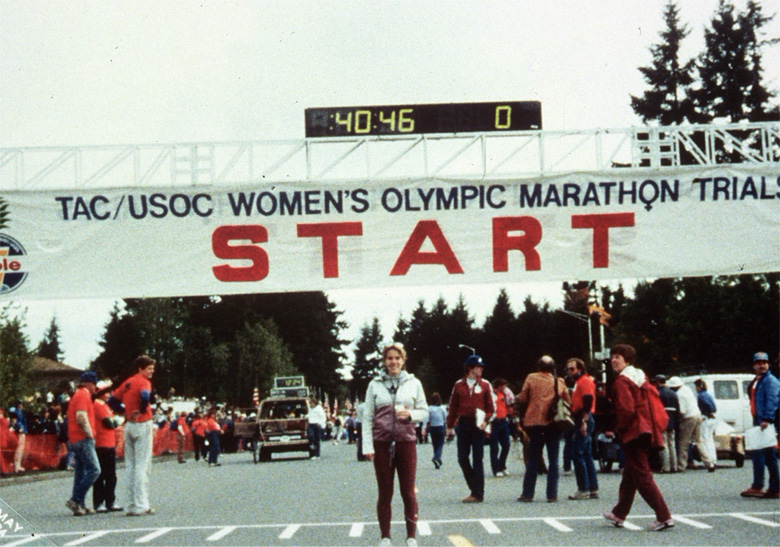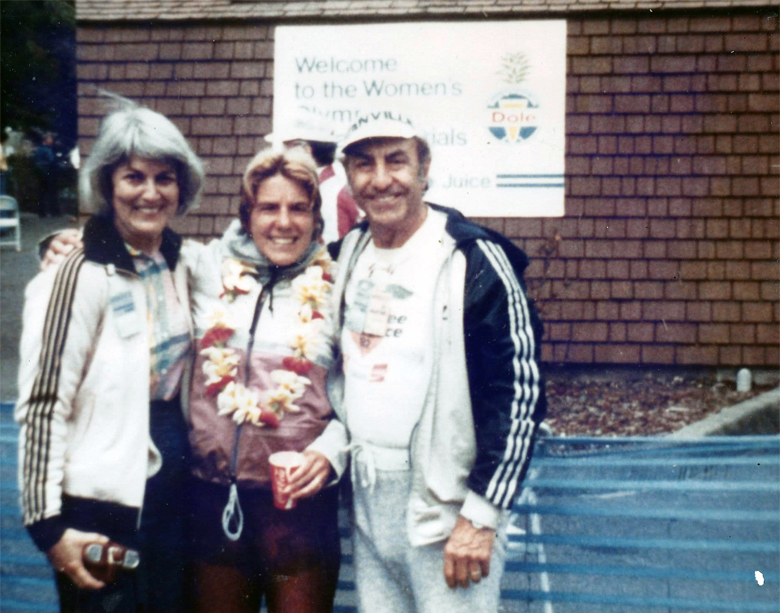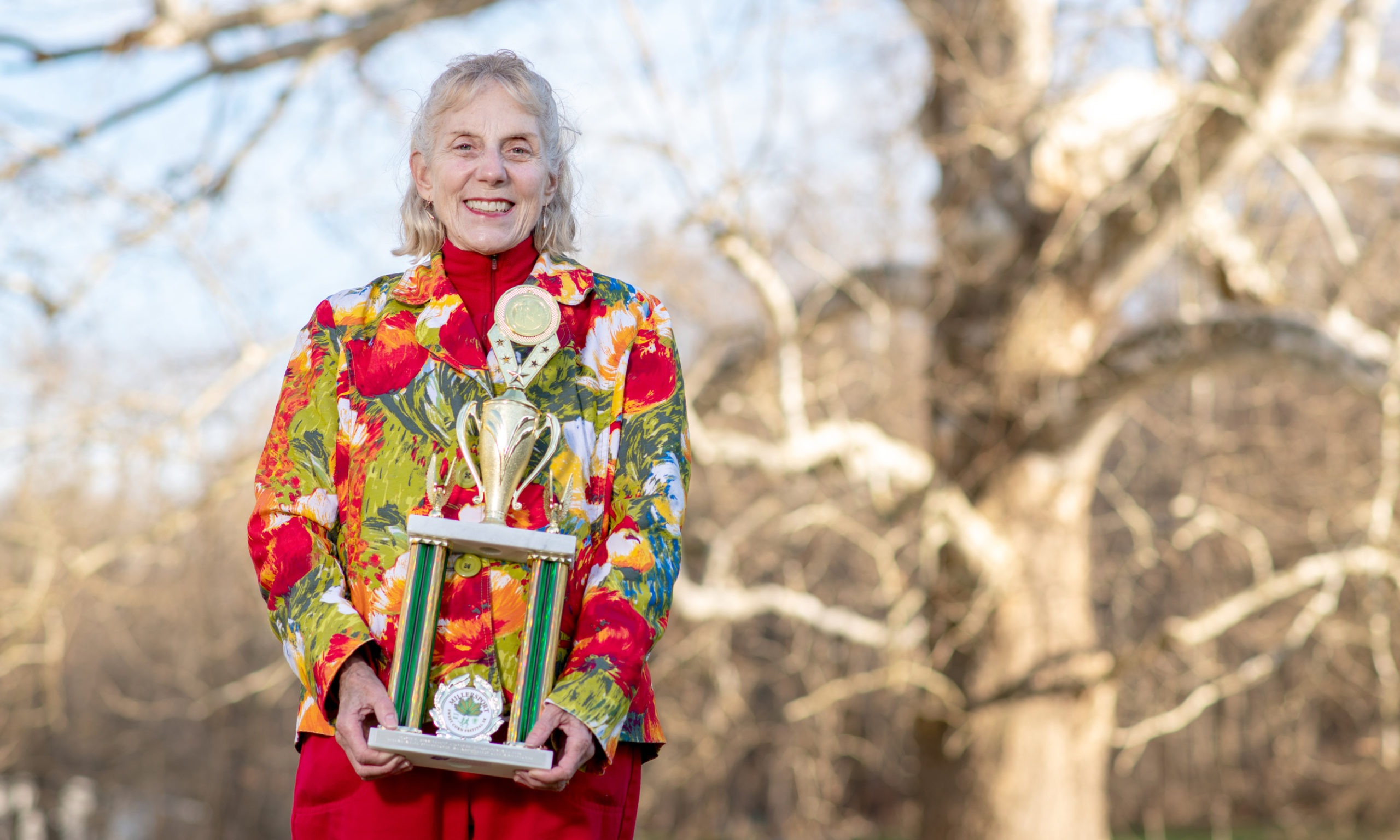Twenty years ago, she left a tenured position at another university for an adjunct opening at OHIO—an opportunity, she says, that brought her closer to home and aligned with her educational training and passion.
As a child, Consolo didn’t fancy herself an athlete. “I couldn’t catch or throw. I’d always be picked last for teams, and I hated phys ed class,” she recalls.
But the year she spent in England as a high school student changed all that. Living in a house on the English Channel, she took up running in the morning, and a local female athlete took her under wing, sparking in Consolo a desire for “excellence in mind and body.”
A trophy she received in a five-mile race back home in Granville, Ohio, inspired Consolo to pursue running in college. As a first-year student, she competed—and succeeded—on the men’s cross-country team at Wake Forest University, paving the way for a women’s team at the university the following year and launching her remarkable running resume.
That first year at Wake Forest, Consolo qualified for Women’s Nationals in the three mile, and, in 1977, she won the 15-mile Charleston Distance Run, earning her sponsorship from Nike. Consolo set her sights on her first marathon and was inspired to join an international movement that successfully advocated for a woman’s marathon at the Olympic Games.
“It changed history,” she says. “Back in the ’80s, you had to fight to be a woman’s distance runner. I would go to races and sometimes come in first woman overall—and not even get a trophy because they had no overall awards let alone age group awards for women. We’ve come a long way, baby.”
In 1984, Consolo qualified for and competed in the trials for that inaugural women’s Olympic marathon, and, in 2013, she placed eighth in the nation in her age group in the 10K Road Race at the National Senior Games, where she was selected out of 11,000 athletes to carry the torch and light the event cauldron.
Over the course of her life, Consolo has won more than 440 races and remained undefeated in all nine races in her age group during her most recent and 46 th race season—all while battling severe allergies, exercise-induced asthma and severe neck, spine, rib and hip injuries from a bad fall. For her, “exercise is medicine.”
In her classes at Ohio University, Consolo uses her passion and experience to inspire OHIO students to live what they are learning. She teaches a course on healthy lifestyle choices (Health 2020), intro to public health (Health 2000) and human biology (Bios 1030), and a couple of years ago, Consolo developed a one-credit wellness workshop (UC 2900 Special Topics)—an afternoon focused on mental, emotional and physical wellness—because, she says, “I saw a real need.”
Ohio Today caught up with Consolo ahead of her 47 th running season to talk about her life in and outside the classroom.

Dr. Kitty Consolo, associate professor of health sciences and recipient of the 2022 Ohio University Zanesville Outstanding Teacher Award, is pictured at the starting line at the trials for the 1984 inaugural women’s Olympic marathon. Photo provided by Kitty Consolo.
How has your passion for running merged with your professional life and teaching?
What I love about teaching is I love to learn, and I love to get students excited about learning. But I also believe that to be able to be the best learner you have to have excellence of mind and body. Research after research has now shown that aerobic exercise like running sharpens your brain. It can relieve depression as effectively as antidepressants and last longer.
So, I really try to instill in my students’ minds a passion for learning and how to learn. I teach a lot of study skills but then also share with them studies where they have kids do aerobic exercise before they take these required math tests in school and they score better regardless of economic income or how well off the school is. We know that aerobic exercise is good for the brain, not to mention it helps a whole lot of other issues. … We can’t separate the brain from the body. If you have a healthy body, you’re going to have a healthy brain, and you’re going to do well in school.
How does your teaching impact the lives of your students outside of their professional goals?
Maybe when you have my class, you’re not really in the position to make a lot of (personal) change. But the information is still there. A couple years ago, I got this email and picture from a student that during my healthy choices class had no time to exercise. But, two years later, she and her family had all taken up walking. They entered this 5K race. They each lost 50 pounds, and they looked amazing. This student, who really didn’t show any health improvement during that class, still applied what she had learned a couple years later, and now her whole family was healthy—and they had an activity that they could do together. And to me, that is real success.
In biology, I decided when we talked about the cardiovascular system to include that the heart, when it’s damaged, can cause referred pain. You may not have any chest pain at all, but you might have pain down the arm or jaw pain. I told my students to let everyone in their families know because not everybody knows and they think if their heart doesn’t hurt, they’re fine and don’t need to worry.
A student went home, and his dad was complaining of jaw pain and pain down his arm. He said, “Dad, we just learned this in biology.” … Lo and behold, he was having a heart attack and, thanks to his son, got to the emergency room in time to make a full recovery. … I always try to infuse little tidbits of life-saving information.
It’s just so exciting to know that I’ve really made a difference. … It doesn’t take a whole huge program. It doesn’t take a lot of equipment or membership to a gym. You can do something simple, and it’s so amazing how it can change your life.
What is the best assignment you’ve ever given to your students?
Several years ago, I decided to have my students do a wellness and health style assessment to see what areas in their health or wellness were deficient and write a paper on that. It was something personal, and they look at the barriers they’re facing and decide what they want to improve on—what they’re willing to do and what they have time for—and then actually do it for six weeks. If you have anxiety, maybe cut back on your caffeine and drink more water, or if you don’t do aerobic exercise, add walking. It was totally their choice rather than assigning a topic. They shared their progress with the class every week, so they got to know their classmates, we built community, and we built support. I was blown away. …
I have a student right now who’s a mom, and she works and goes to school—I don’t know how students like that do it. She’s doing art therapy for her pain and stress, and it’s really working. … A lot of people feel guilty about self-care, and yet self-care should really come first. If all of us felt it was okay to make time to get enough sleep, to eat right, to exercise and take care of ourselves, we would all be better off. … What we need is a society that puts health and wellness and well-being first and then everything else is going to be better and follow.
What one or two pieces of advice would you give to someone looking to improve their health and well-being?
The first thing I would say is look into some sort of aerobic exercise. Three hours a week can prevent 70 percent of cancer. It prevents depression, can cure depression and anxiety, lowers obesity, heart disease and builds immunity. … There’s a simple Physical Activity Readiness Questionnaire (PAR-Q) that I use with my students. If you answer yes to anything, you see your doctor first and then you’re good to go (to start an exercise program). It could be swimming, biking, walking, anything. Aerobic exercise definitely is medicine.
The second thing is that I’d have people look at what they put in their body, their diet. The Mediterranean diet is the way to go. Low fat, lots of fruit and vegetables, plenty of water. … I would also add to that organic. It really is healthy.
I think if you have a healthy diet and exercise, you’re going to take care of and prevent most health problems because you’re building a healthy body free of disease and you’re also building an amazing immune system to last a lifetime.
What is your favorite movie and why?
It’s so funny because a couple weeks ago, maybe with the cold weather, I just felt that I was in a real slump, so I pulled out my mainstay, Chariots of Fire . It’s a true story of Harold Abrahams and Eric Liddle in the 1924 Olympic Games in Paris. Harold Abrahams was Jewish, and, of course, in 1924 if you were Jewish, there were a lot of things to fight against. And then Eric Liddle was set to be a missionary and suddenly his heat for the 100 was put on Sunday, and he refused to run on a Sunday because it was, in his opinion, God’s law not to run. He won a gold medal in the quarter, and Harold won the gold and set the world record in the 100.
When I first saw that movie in the 1980s, I was qualifying for Olympic marathon trials, and I was sponsored. I was a lot more like Harold Abrahams. I was intense and was like, “I’m going to show them.” I wasn’t Jewish; I was fighting as a female athlete. …
The other thing about it is that when I run, it’s kind of like Eric Liddle said, “When I run, I really feel God’s pleasure.” I feel this amazing spiritual connection to a higher power, and I also feel amazingly happy.

Dr. Kitty Consolo is pictured with her mom, Jeanne, and her dad, Dom, at the 1984 women’s Olympic marathon trials, which she qualified for and competed in after advocating for the event. Photo provided by Kitty Consolo.
If you could time travel, when and where would you go?
I have this photo of me between my mom and dad at the 1984 Olympic marathon trials. I would love to go back to that day in Olympia, Washington, at the first-ever women’s Olympic marathon trials, where I stood there on that starting line—one of 300 women in the nation that qualified. … I didn’t make the team, but just to be a part of history and know that we won the right and the opportunity to compete in this marathon—and my mom and dad were both there.
My dad was always so busy with his teaching. (Fun fact: Consolo’s father, Professor Emeritus of English at Denison University Dominick Consolo, was the inspiration for the movie Dead Poet’s Society .) He rarely came to any of my races all those years, and he wasn’t even sure he was going to come until the day before the race. My mom got him on that plane. If I could just have that day again with them, it would be amazing. They’ve both passed on.
What is your most prized possession and why?
My health. I’ve really had to struggle my whole life.
I was born full term, but I needed to be in an incubator for the first three weeks. I didn’t get my mom’s breast milk, which is important for all the antibodies, which I’ve learned from my immunologist. I also was severely allergic to cow’s milk. I’m one of the few people that’s allergic—not just lactose intolerant but, I mean, stop-breathing allergic—to dairy and milk. By the time I was in kindergarten, my tonsils were so inflamed I couldn’t even walk and breathe, so I had my tonsils out. And that helped a lot.
But what really saved me was in 1972 when I decided to join the Newark YMCA swim team because the football coach at Denison, Keith Piper, was watching me in the pool and said I had potential. … He had no idea that I struggled to breathe all the time and had these horrible allergies. Years later at Wake Forest, I was asked to take our guest speaker, who was treating cystic fibrosis patients by having them run, on a run. And during this run, I started wheezing like I always did, and he said, “You know, you have exercise induced asthma.” I’m like, what? I can’t have asthma and run.
I had been running for years with asthma, and no one ever knew. I’d never been treated, and now I have an amazing immunologist, Dr. Michael Waickman in Fairlawn, Ohio, who I’ve worked with for over 20 years, that really has things down pat. I hardly ever have breathing issues, but I am very, very careful. I do 40 minutes of breathing treatments a day and all kinds of stuff.
I have accommodation not to start teaching until the afternoon because when I wake up, I have vertigo and a lot of issues. I have to do eye exercises, breathing treatments, drops, drugs, and then I run—running is actually part of my physical therapy because it opens my lungs—and stretching, and then I’m finally ready to go. I have to be really careful about indoor air, and I’m so grateful the University is allowing me to work from home even though, yes, I’d much rather be live in the classroom.
So, I think my health is really valuable because each day is such a struggle. I am so grateful for my coach and physical therapist, Jon Plush (Nova Care), who has worked tirelessly since 2009 to enable me to still compete and comes to my races to make sure I get oxygen at the finish line. I can’t rely on inhalers. I am also grateful for the support of my husband, Barry Allman, who encourages me to never give up.
What is something you’re excited about right now?
For the last 20 years, I’ve been lucky to go to the annual Ohio Association for Health, Physical Education, Recreation and Dance State Convention and meet with coaches and colleagues in health and phys ed and do a presentation on something healthy to help athletes. We didn’t get to go last year because of COVID. This year, they’re not going to have it live, but fortunately we just heard they’re going to have it virtually. Even though it’s not live, it’s going to be so great to connect with those colleagues across the state. Students can go, high school and college students, and it’s a good way to promote OU. I’m going to be talking about best practices to boost immunity in distance runners. I always try to find something really appropriate for the time and practical.
I’m also looking forward to my 47 th racing season, and next year is the qualifying year for the 2023 National Senior Games in Pittsburgh. Between the conference, my teaching and my racing, there’s a whole lot to look forward to.
Feature image: Dr. Kitty Consolo, associate professor of health sciences at Ohio University’s Zanesville Campus, is seen with her most recent running achievement: the trophy she won after taking first place in her division at the 2021 Millersport 5K in September. Photo by Rich-Joseph Facun, BSVC ’01


